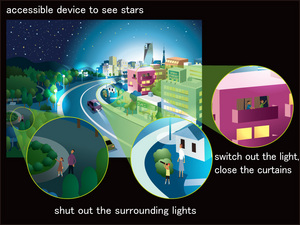Nagoya City Science Museum
TOP > Exhibition Guide > Keyword Search > Starting with "O" > observation > Light Pollution and Starry Sky
Light Pollution and Starry Sky



Purpose of Exhibition
In urban areas, you can see only a few stars even on a clear night. This is not because the air in cities is dirty, but because streetlights and other ground sources leak upwards and illuminate the night sky.A bright sky reduces the difference in brightness (contrast) from the stars and makes it harder to see them.
“Light Pollution” is the term used to describe this kind of situation, where lighting conditions have failed to give sufficient consideration to the landscape and surrounding environment. On the other hand, if provided a well-considered light environment, you could enjoy many stars even in the city.
This exhibit will show you the correlation between city lights and the night sky; a hands-on display and aerial photos demonstrate how the night sky brightness awfully blots out the stars.
Additional Knowledge
[Light Pollution Control and How to Stargaze in Cities]
The first step of light pollution control would be to go back to the original purpose for which we installed the lights and create an appropriate lighting environment. We can put shades on the street lights that prevent upward leakage, so that we direct light only to where it is needed or wanted. Such prudence would give us more pleasant and comfortable circumstances for stargazing. Besides, it will also help to reduce electricity consumption.
When viewing the night sky on the street, it is important to keep the direct glare from nearby lights out of your eyes. You can get into the shadow of a tree. Your own hands will help block surrounding light sources such as street lamps. Or, you can roll up black sheet and make a long, thin tube.
When from your balcony, you should turn off the lights in your house as much as possible and close the curtains tightly to allow less light to leak out. Stay in the darkness for 10 to 15 minutes as your eyes get dark adapted, and then look up at the night sky, which will reveal more stars to you than usual.
This page was last edited on 15 June 2022.
Article by Astronomy Section
